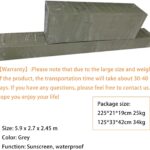Finding the best ways to heat a garage becomes urgent when you’re standing there on a freezing January morning, breath visible in the air, trying to work on a project with numb fingers.
You’re not alone.
I’ve been there – attempting to change car oil when it’s -10°C outside, tools so cold they hurt to touch, and wondering why I didn’t research the best ways to heat a garage years ago.
Here’s what most articles won’t tell you: the best ways to heat a garage aren’t just about buying the biggest heater you can find.
It’s about understanding your specific situation, matching the right heating solution to your needs, and avoiding the costly mistakes that leave you with sky-high energy bills or, worse, safety hazards.
This guide reveals the best ways to heat a garage with 11 proven methods that actually work in real-world conditions.
The Problem: Why Most Garage Heating Solutions Fail
Last winter, my mate Dave spent $1080 on a “professional-grade” garage heater.
Three months later, his energy bill doubled, the garage was still freezing in the mornings, and condensation was ruining his tools.
Sound familiar?
Here’s why most people get garage heating wrong:
They don’t calculate BTUs properly – throwing money at oversized or undersized units that waste energy or fail to heat effectively.
They ignore insulation – trying to heat an uninsulated space is like filling a bucket with holes.
They focus only on equipment cost – missing the bigger picture of installation costs, operating costs, and long-term efficiency.
They don’t consider their actual usage patterns – installing a $2700 system to heat a garage they use twice a month.
The result? Frustration, wasted money, and garages that are still bloody cold.
The Solution: Strategic Garage Heating That Actually Works
The best ways to heat a garage aren’t about finding one perfect solution.
It’s about matching your heating method to three key factors:
- Your usage patterns (daily workshop vs weekend projects)
- Your garage type (attached vs detached, insulated vs bare walls)
- Your climate zone (how cold it actually gets)
Get these right, and you’ll have a warm, comfortable space without breaking the bank.
Here’s the complete breakdown of the best ways to heat a garage with 11 proven options that cover every situation, budget, and need.
11 Proven Ways to Heat Your Garage
These are the most effective and proven best ways to heat a garage that I’ve tested and researched extensively.
1. Insulation First – The Foundation of Garage Heating
Before you buy any heater, sort your insulation.
I know it’s not sexy, but insulate garage door DIY projects can reduce your heating costs by 30-50%.
What works:
- Reflective foil garage door panels ($65-135)
- Wall insulation (R-13 to R-15 for most climates)
- Weatherstripping around doors and windows
Reality check: A well-insulated garage needs 60% less heating capacity than an uninsulated one.
🛒 Get Professional Garage Door Insulation Kit on Amazon – Transform your cold garage into a comfortable workspace with this easy-to-install insulation solution that pays for itself in energy savings.
2. Propane Space Heaters – Fast Heat for Quick Jobs
Ventless propane heater pros and cons make this option perfect for specific situations.
Best for: Weekend warriors who need fast heating for short jobs garage work.
Pros:
- Heats quickly (10-15 minutes to comfortable temperature)
- No electrical requirements
- Portable and flexible
- Low upfront cost ($135-405)
Cons:
- Creates moisture and combustion gases
- Requires proper ventilation
- Ongoing fuel costs
Safety note: Always use carbon monoxide alarms with any propane heating solution.
🔥 Shop Top-Rated Propane Garage Heaters on Amazon – Get instant heat without electricity! Perfect for power outages and remote garages. Customers love these portable units for their reliability and fast heating.
3. Electric Space Heaters – Convenient but Limited
The portable space heater for garage option everyone considers first.
Best for: Smaller garages (under 400 sq ft) with good insulation and reliable electricity.
What to know:
- 240V heaters are more efficient than 120V
- Look for 5000-7500 watts for most single-car garages
- Space heater electricity usage can be $4-8 per day of heavy use
Pro tip: Get one with a built-in thermostat to avoid constant on/off cycles.
⚡ Browse Best Electric Garage Heaters on Amazon – Clean, quiet, and efficient heating at your fingertips. These customer-favourite models offer precise temperature control and safety features that give you peace of mind.
4. Ductless Mini Split Heat Pumps – The Premium Choice
This is where mini split technology shines for garages.
Best for: Year-round garage use, attached garages, and areas where you need both heating and cooling.
Why they work:
- Heat AND cool (bonus points for summer)
- Extremely energy efficient
- Quiet operation
- Professional installation ensures safety
Investment reality:
- Ductless mini split heat pump cost ranges from $2025-4725 installed
- ROI typically 3-5 years through energy savings
❄️🔥 Discover Premium Mini Split Systems on Amazon – The ultimate garage climate control solution! Heat in winter, cool in summer, save money year-round. Professional installers recommend these energy-efficient units for their reliability and performance.
5. Radiant Floor Heating – Ultimate Comfort
In-floor radiant garage heating provides the most comfortable heat distribution.
How it works:
- Electric mats or hydronic tubes under the floor
- Heat rises evenly from ground up
- No air movement means no dust circulation
Best for: New construction or major garage renovations.
Investment: Radiant floor heating system installation runs $11-20 per square foot.
The comfort factor: Once you experience radiant floor heat comfort, everything else feels inferior.
🌡️ Shop Radiant Floor Heating Systems on Amazon – Experience luxury garage heating that heats from the ground up! Perfect for new construction or renovations. Transform your garage into the most comfortable workspace you’ve ever had.
6. Wood Burning Stoves – Old School Reliability
Wood stove for garage use appeals to those who want independence from utilities.
Advantages:
- Low operating costs (if you have wood access)
- Creates a cosy atmosphere
- Works during power outages
- High heat output
Requirements:
- Proper venting and chimney
- Floor protection
- Regular maintenance
- Building codes compliance
🪵 Find Quality Wood Stoves for Garages on Amazon – Go off-grid with reliable wood heating! These rugged stoves provide consistent warmth even during power outages. Perfect for the self-sufficient garage owner who values independence.
7. Pellet Stoves – Modern Wood Heating
Pellet stove for a large garage combines wood heating convenience with modern efficiency.
Why they’re better than traditional wood stoves:
- Automated fuel feeding
- Consistent heat output
- Cleaner burning
- Thermostat control capability
Best for: Large garages (600+ sq ft) where you spend significant time.
🌾 Explore Efficient Pellet Stoves on Amazon – Modern convenience meets traditional warmth! Auto-feeding pellet stoves give you consistent heat with minimal effort. Ideal for workshop enthusiasts who want reliable, eco-friendly heating.
8. Forced Air Heaters – Professional Workshop Solution
These are the workhorses of commercial garage heating.
Types available:
- Natural gas (most cost-effective for constant use)
- Propane (for areas without gas lines)
- Electric (cleanest but highest operating costs)
Best for: Daily workshop use, commercial applications, large spaces.
Installation note: Requires proper venting and often professional installation.
💨 Check Out Professional Forced Air Heaters on Amazon – Industrial-strength heating for serious workshops! These powerhouse units heat large spaces quickly and efficiently. Contractors and serious DIYers swear by these reliable workhorses.
9. Infrared Heaters – Targeted Warmth
Infrared energy heats objects directly rather than warming air.
Perfect for:
- Spot heating work areas
- High-ceiling garages
- Drafty spaces where convection heating fails
How they work:
- Mount on walls or ceiling
- Heat you and your workbench directly
- Don’t waste energy heating empty air space
🎯 Get Targeted Infrared Heaters on Amazon – Smart heating that targets exactly where you work! No more heating empty air – these efficient heaters warm you and your projects directly. Perfect for spot heating and high-ceiling garages.
10. Extending House HVAC – The Attached Garage Solution
For heating an attached garage, extending your home’s system might make sense.
When it works:
- Well-insulated garage
- Adequate HVAC capacity
- Professional ductwork installation
When it doesn’t:
- Creates pressure imbalances
- Can pull garage air (and fumes) into house
- May violate building codes
11. Combination Approach – Best of Both Worlds
Smart garage owners often use multiple heating methods:
Example setup:
- Mini split for primary heating/cooling
- Infrared heater for spot heating specific work areas
- Portable propane for emergency backup
This gives you efficiency, flexibility, and redundancy.
How Many BTUs Do You Actually Need?
Most garage heater size calculator tools overcomplicate this.
Here’s the simple formula:
Basic calculation: Garage square footage × 20-25 BTUs = heating requirement
Adjust for:
- Climate zones: Add 25% for extremely cold areas
- Insulation quality: Subtract 30% for excellent insulation
- Ceiling height: Add 10% for each foot over 8 feet
- Attached vs detached garage: Attached needs 20% fewer BTUs
Example: 400 sq ft garage, average insulation, cold climate
400 × 25 × 1.25 = 12,500 BTUs needed
Safety Considerations You Can’t Ignore
Heating a garage safely and reliably means addressing these non-negotiables:
Ventilation requirements:
- Any combustion heater needs fresh air intake
- Exhaust gases must be properly vented
- Carbon monoxide danger is real – install detectors
Fire hazards:
- Keep heaters away from flammable materials
- Maintain clearances specified by manufacturer
- Consider automatic shut-off features
Electrical safety:
- 240V heaters need proper circuits
- Use GFCI protection in damp environments
- Professional installation for hardwired units
Cost Breakdown: What You’ll Actually Spend
Let’s get real about money.
Equipment costs:
- Portable space heaters: $135-675
- Propane heaters: $270-1080
- Mini splits: $2025-4725 installed
- Radiant floor systems: $2700-8100 installed
Operating costs (estimated monthly for 400 sq ft garage, 8 hours daily use):
- Electric space heater: $108-162
- Propane: $81-122
- Mini split heat pump: $54-95
- Natural gas forced air: $41-68
Installation costs:
- DIY installation: $0-270 (basic units)
- Professional: $675-2700 depending on complexity
- Permit requirements vary by location and heating type
The Smart Installation Strategy
Choosing among the best ways to heat a garage depends on your specific situation:
For renters or budget-conscious: Start with portable electric or propane heaters plus basic insulation improvements.
For homeowners planning to stay: Invest in mini split or forced air systems with professional installation.
For workshop enthusiasts: Consider radiant floor heating for new construction or major renovations.
For occasional use: Infrared heaters plus good insulation provide targeted warmth without heating the entire space.
Common Mistakes That Cost Money
Mistake 1: Buying based on square footage alone without considering insulation quality.
Mistake 2: Installing oversized units that cycle on/off constantly, wasting energy and reducing lifespan.
Mistake 3: Ignoring moisture/condensation issues – heating without proper ventilation creates bigger problems.
Mistake 4: Not factoring in energy efficiency ratings when comparing options.
Reality check: A properly sized, efficient system costs less to run than an oversized “powerful” unit.
Frequently Asked Questions
Q: What’s the cheapest way to heat a garage?
A: Cheap heat for garage starts with insulation improvements ($135-405) plus a quality electric space heater ($270-540). This combination works for occasional use and smaller spaces.
Q: Can I heat a detached garage the same way as an attached one?
A: Heating a detached garage requires more heating capacity due to increased heat loss and typically can’t use house HVAC extension. Focus on standalone solutions like mini splits or forced air units.
Q: How long does it take to heat a cold garage?
A: Depends on heating method and insulation. Propane heaters: 15-30 minutes. Electric space heaters: 30-60 minutes. Mini splits: 20-45 minutes. Radiant floor: 1-2 hours but maintains temperature longer.
Q: Do I need permits for garage heating installation?
A: Permit requirements vary by location and heating type. Generally, hardwired electrical work, gas line installation, and venting modifications require permits. Portable units typically don’t.
Q: Is it safe to leave garage heaters on overnight?
A: Only units specifically designed for unattended operation should run overnight. Mini splits and radiant systems are generally safe. Portable space heaters and propane units should not be left unattended.
The Bottom Line
The best ways to heat a garage in winter work effectively when you match your heating solution to your actual needs, not your wishful thinking.
Start with insulation – it’s the foundation everything else builds on.
For occasional use, quality portable heaters work fine.
For regular use, invest in permanent solutions like mini splits or forced air systems.
For ultimate comfort, radiant floor heating can’t be beat.
The key is being honest about how you actually use your garage and choosing accordingly.
Your future self, working comfortably in a properly heated garage, will thank you for making the right choice now.
Ready to stop shivering in your garage? Pick from these proven best ways to heat a garage, start with proper insulation, and transform your cold garage into a comfortable workspace this winter.







